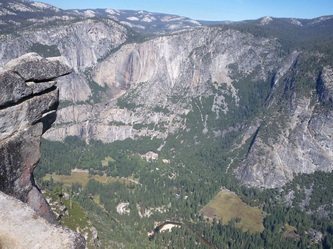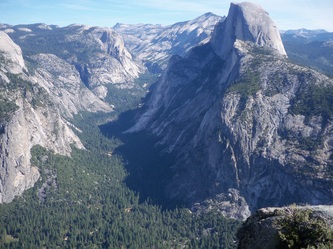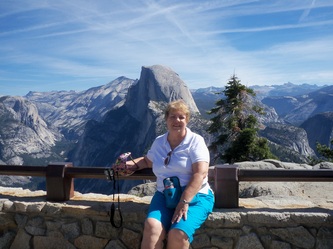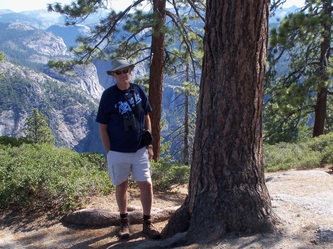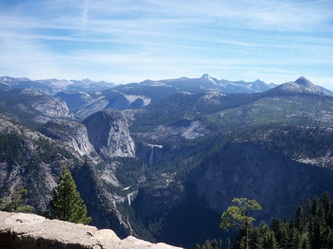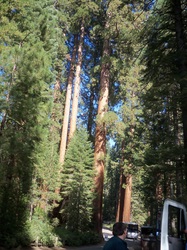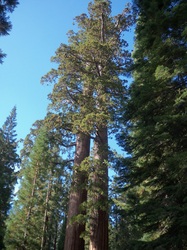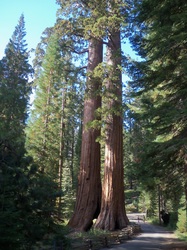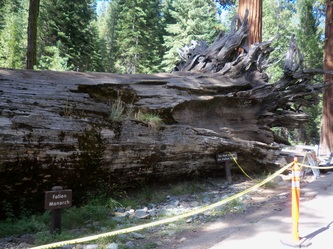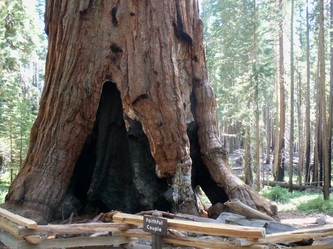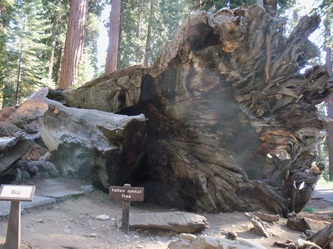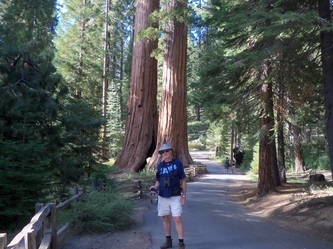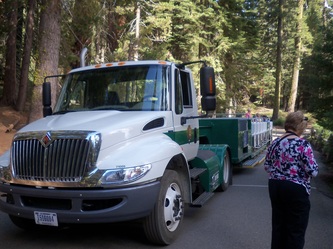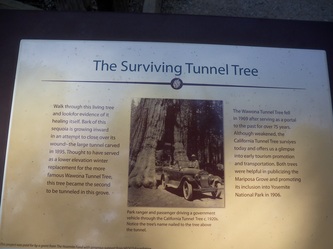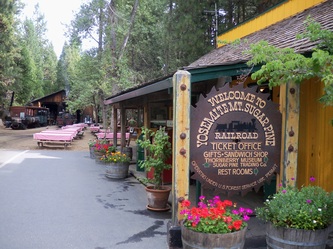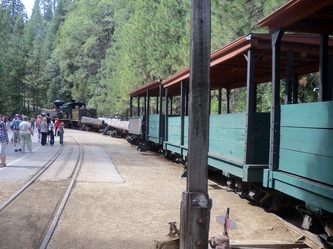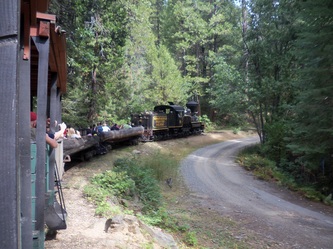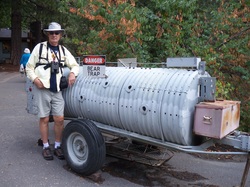
Gary by a bear trap.
Gary found us a hotel for the night. He thought it looked pretty reasonable.
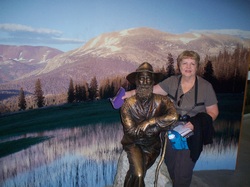
Susan at the visitor's center with John Muir.
Susan found a new boyfriend, John Muir.
Wednesday, September 28;
Our plan for the day was to drive to Glacier Point. Our lodge had complimentary rolls, fruit, and other breakfast items, so needless to say this is where we had breakfast for the next three mornings. The drive to Glacier Point is back through the south entrance to the park. The view from Glacier Point is massive. You can see most of Yosemite Valley, Yosemite Falls, Vernal Falls, Nevada Falls, Half Dome, Three Brothers, El Capitan and points beyond. We could see people who made the twelve mile (round trip) hike to the top of Half Dome. Out of our view was the backside of Half Dome where the hikers can use cables to aid them up the last 680 feet of elevation. People have died on this hike when the granite gets slick or icy.
Glacier Point is also the end of the four-mile trail, which John Muir built with his own funds so people could enjoy the view. This trail from the valley floor ascends 4300 feet so it is a steep climb. Gary walked almost a mile down and it was not too bad. He met several hikers on the way up. He also saw a mother mulie with twins. The little ones did the mule deer 'pronk' to catch up to their mother. There were several awe-inspiring views in just this short walk. We then left Glacier Point and headed back toward the south entrance.
Our plan for the day was to drive to Glacier Point. Our lodge had complimentary rolls, fruit, and other breakfast items, so needless to say this is where we had breakfast for the next three mornings. The drive to Glacier Point is back through the south entrance to the park. The view from Glacier Point is massive. You can see most of Yosemite Valley, Yosemite Falls, Vernal Falls, Nevada Falls, Half Dome, Three Brothers, El Capitan and points beyond. We could see people who made the twelve mile (round trip) hike to the top of Half Dome. Out of our view was the backside of Half Dome where the hikers can use cables to aid them up the last 680 feet of elevation. People have died on this hike when the granite gets slick or icy.
Glacier Point is also the end of the four-mile trail, which John Muir built with his own funds so people could enjoy the view. This trail from the valley floor ascends 4300 feet so it is a steep climb. Gary walked almost a mile down and it was not too bad. He met several hikers on the way up. He also saw a mother mulie with twins. The little ones did the mule deer 'pronk' to catch up to their mother. There were several awe-inspiring views in just this short walk. We then left Glacier Point and headed back toward the south entrance.
We drove about twenty miles to the Wawona Visitor's Center near the south entrance. We visited a history museum and caught a bus to the Mariposa Grove of Giant Sequoias. After getting off the bus, we got tram tickets for a tour of the grove. (Gary would like to be sure I include the information that each ticket cost $25.) Cars are not allowed in the grove. It was a dry and dusty tram ride but the information announced was very educational about the trees. The grounds around the sequoias are protected because they learned that as the ground packs from all the people walking on it, there is damage to the root growth of these trees. These trees are shallow rooted. Some of the trees have walking paths near them, but not the famous ones like the
Faithful Couple and the Grizzly Giant. That is the tree that John Muir and Theodore Roosevelt camped under.
Faithful Couple and the Grizzly Giant. That is the tree that John Muir and Theodore Roosevelt camped under.
The famous trees are fenced off. All sequoias and large pines have fire scares and some are substantial. More than a few are burned all the way through. The Clothespin Tree burned through 15 feet by 75 feet tall and it still lives. Our tour lasted about an hour and then we went back to the bus to return to Wawona. There was a Wawona Resort that looked to be another golf-focused inn. It had a restaurant and we just decided to eat there since it was dinnertime. Again, great food and wine. We drove to the south entrance of the park and then on to Fish Camp. We were driving in the dark, but we were beginning to feel like veteran mountain drivers.
Thursday, September 29;
Gary wanted to return to the Mariposa Grove of Giant Sequoias and walk on the ranger-guided tour. There is significant elevation to this walk so Susan opted out of this tour. Gary enjoyed the tour and got a lot of information that was more embellished than the tram tour of the previous day. He learned that the sequoia sap is so tannic that organisms don't live in the wood. That's the main reason they get so old. They never succumb to disease or insects. The only danger to the trees is fire (minor cause) and wind (major cause). There is an old fallen tree along the route, the Fallen Monarch, that was there when they discovered the grove and estimate it to be 200 years old. It is still bug free and contains no fungus or rot. It doesn't break down either. One thing that helped the sequoias survive man in the early days is that its wood isn't very usable. Shingles and pencils can be made but the trees shatter easily. The wood is brittle. Gary learned about the pinecones of the ponderosa and sugar pines as well as the sequoia pines. Sugar Pine cones are large (a foot long). The Ponderosa pine is about palm size and the Sequoia is slightly smaller. The actual sequoia seed looks like a flake of oatmeal. Squirrels and chipmunks eat them. The ranger had a lengthy discourse on fire. Locals don't like it, but beginning in the 1960's naturalists realized that the understory was not letting them germinate. Seeds were not getting to the bare soil. They estimated that fire occurs naturally in any and all specific locations every ten to twelve years. That is now what foresters do. Every ten to twelve years means those trees have been through hundreds of fires over their life span. No wonder all have black bark. Gary saw squirrels, chipmunks, and a pileated woodpecker on this walk. Gary returned to the Narrow Gauge Lodge about 1:30 p.m.
Susan decided to spend the morning riding on the Narrow Gauge Railroad. It was a ride on open seating cars behind a stem engine. It was just scenic and we made a couple of stops. One stop was at an ampitheatre where plays are given during the summer months.
Gary wanted to return to the Mariposa Grove of Giant Sequoias and walk on the ranger-guided tour. There is significant elevation to this walk so Susan opted out of this tour. Gary enjoyed the tour and got a lot of information that was more embellished than the tram tour of the previous day. He learned that the sequoia sap is so tannic that organisms don't live in the wood. That's the main reason they get so old. They never succumb to disease or insects. The only danger to the trees is fire (minor cause) and wind (major cause). There is an old fallen tree along the route, the Fallen Monarch, that was there when they discovered the grove and estimate it to be 200 years old. It is still bug free and contains no fungus or rot. It doesn't break down either. One thing that helped the sequoias survive man in the early days is that its wood isn't very usable. Shingles and pencils can be made but the trees shatter easily. The wood is brittle. Gary learned about the pinecones of the ponderosa and sugar pines as well as the sequoia pines. Sugar Pine cones are large (a foot long). The Ponderosa pine is about palm size and the Sequoia is slightly smaller. The actual sequoia seed looks like a flake of oatmeal. Squirrels and chipmunks eat them. The ranger had a lengthy discourse on fire. Locals don't like it, but beginning in the 1960's naturalists realized that the understory was not letting them germinate. Seeds were not getting to the bare soil. They estimated that fire occurs naturally in any and all specific locations every ten to twelve years. That is now what foresters do. Every ten to twelve years means those trees have been through hundreds of fires over their life span. No wonder all have black bark. Gary saw squirrels, chipmunks, and a pileated woodpecker on this walk. Gary returned to the Narrow Gauge Lodge about 1:30 p.m.
Susan decided to spend the morning riding on the Narrow Gauge Railroad. It was a ride on open seating cars behind a stem engine. It was just scenic and we made a couple of stops. One stop was at an ampitheatre where plays are given during the summer months.
After our tours we decided to relax by the pool and read. Gary jumped in but it was too cold for Susan. We could have jumped in the hot tub, but it was too cold outside to get wet. It was very peaceful. They have beautiful landscaping with gobs of flowers around the pool and the lodge. There were signs everywhere not to leave food in you car or in the trash after the daily pickup. Bears! We didn't see any. We finished off a bottle of fuzzy navel. Gary went to the office and bought a bottle of wine. We were very mellowed by dinnertime. This was our last night at the Narrow Gauge Inn. We had dinner in their restaurant. Again, great food and wine.
Friday, September 30;
We packed to return to Fresno. We decided that we would visit a winery on the return trip. We were surprised at the miles of pistachio trees in the San Joaquin Valley. We got pretty lost and drove through a maze of grape groves. These were very of-of-the-way rough roads but we finally made it to the
Cru Winery.
The winery personnel were very accommodating. We tasted five wines and a hospitality lady filled our glasses one last time and conducted a tour just for us. It was past the tourist season so they were not busy with tourists. They also gave us sandwiches leftover from a meeting. Susan bought six bottles of our favorites wines. They were shipped home.
Next to the winery was a gift shop specializing in pistachios. We bought pistachios and then headed on to Fresno. We off loaded our luggage at our hotel that was just across the street from the airport. Gary took the rental car to the airport and then walked back to the hotel. It was just one-quarter mile from the airport. We spent some time at the hotel pool. Gary smoked a cigar, Susan read and then we went to happy hour and dinner at the hotel.
Saturday, October 1;
We had an early flight. We went to the airport on the hotel shuttle. Gary got an exit row seat to Dallas, but Susan did not. Susan got to sit by a mother with a nine-month-old baby--of course. The flight went pretty smoothly and the baby was pretty good. That is--until he finished his bottle and fell asleep on his mother's shoulder, just next to Susan's shoulder. He suddenly woke up and threw up his whole bottle on Susan! Susan had to change to the gift T-shirt she bought Todd when we got to Dallas. We had a two and a half hour layover in Dallas and then on the K.C. We both had exit row seats. We had no problems on the return flight and Bryan picked us up at KCI.
We had a great trip and would recommend visiting Yosemite National Park to anyone that has not seen it. We will never forget the beauty of Yosemite. As always it's good to get home because there's no place like home in Kansas.
Friday, September 30;
We packed to return to Fresno. We decided that we would visit a winery on the return trip. We were surprised at the miles of pistachio trees in the San Joaquin Valley. We got pretty lost and drove through a maze of grape groves. These were very of-of-the-way rough roads but we finally made it to the
Cru Winery.
The winery personnel were very accommodating. We tasted five wines and a hospitality lady filled our glasses one last time and conducted a tour just for us. It was past the tourist season so they were not busy with tourists. They also gave us sandwiches leftover from a meeting. Susan bought six bottles of our favorites wines. They were shipped home.
Next to the winery was a gift shop specializing in pistachios. We bought pistachios and then headed on to Fresno. We off loaded our luggage at our hotel that was just across the street from the airport. Gary took the rental car to the airport and then walked back to the hotel. It was just one-quarter mile from the airport. We spent some time at the hotel pool. Gary smoked a cigar, Susan read and then we went to happy hour and dinner at the hotel.
Saturday, October 1;
We had an early flight. We went to the airport on the hotel shuttle. Gary got an exit row seat to Dallas, but Susan did not. Susan got to sit by a mother with a nine-month-old baby--of course. The flight went pretty smoothly and the baby was pretty good. That is--until he finished his bottle and fell asleep on his mother's shoulder, just next to Susan's shoulder. He suddenly woke up and threw up his whole bottle on Susan! Susan had to change to the gift T-shirt she bought Todd when we got to Dallas. We had a two and a half hour layover in Dallas and then on the K.C. We both had exit row seats. We had no problems on the return flight and Bryan picked us up at KCI.
We had a great trip and would recommend visiting Yosemite National Park to anyone that has not seen it. We will never forget the beauty of Yosemite. As always it's good to get home because there's no place like home in Kansas.
